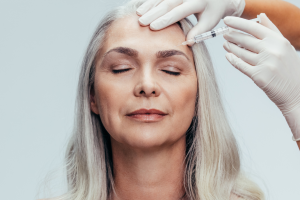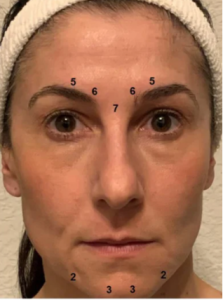
Botox (Botulinum Toxin or BTX) is a household name synonymous with wrinkle reduction and a youthful appearance. But in recent years, researchers have delved deeper into its potential applications, venturing into the realm of treating mental health conditions like depression. Is this one of those bright shiny objects of medical therapies? At first, we here at MindStream weren’t sure, but when presented with a treatment that doesn’t involve a daily medication for a common condition that affects many of our patients, we read on! This potential has sparked a wave of curiosity and questions: can Botox really lift not just our faces, but also our moods?
Important: please keep in mind the information in this post is just information and does not constitute medical advice; if you are considering botulinum toxin for any reason, please consult with your treating provider for a thorough discussion of the risks, benefits, and intended effects of the medication.
Depression Facts

Before digging deeper into Botox’s potential for treating depression, we must understand more about the condition itself. Here are some important facts about depression:
- Depression is common. From Gallup: “The percentage of U.S. adults who report having been diagnosed with depression at some point in their lifetime has reached 29.0%, nearly 10 percentage points higher than in 2015. The percentage of Americans who currently have or are being treated for depression has also increased, to 17.8%, up about seven points over the same period. Both rates are the highest recorded by Gallup since it began measuring depression using the current form of data collection in 2015.”
- It’s hard to treat. When we use antidepressants such as sertraline, escitalopram, or fluoxetine, we must treat between 7 to 16 people in order to relieve depression in one person. This is called an “NNT”, or number needed to treat, which is a good way to understand the effectiveness of a treatment or intervention.
- Depression can be “treatment resistant”. This means that even when patients seek treatment using medications and other interventions, about 31% remain depressed.
- Not much has changed in depression treatment over the last 40 years. This is very frustrating to patients seeking help for their symptoms. However recently, in addition to the use of psychedelics for conditions like PTSD, anxiety, and treatment-resistant depression, some new approaches are gaining traction. These emerging approaches include exercise, hyperthermia, and apparently even Botox!
What is Botulinum Toxin (BTX)?

Botulinum Toxin (or BTX) is sold under various brand names, such as Dysport®, Xeomin®, Jeuveau®, Daxxify®, and Myobloc®. However, its most common brand name is BOTOX Cosmetic®. It’s so common in fact that people often use the word ‘Botox’ as a catch-all to describe any BTX product. To limit confusion, we will also refer to BTX products as ‘Botox’ throughout this post.
While dangerous when accidentally ingested, this neurotoxin produced by Clostridium bacteria has been used since the early 1970s to treat conditions such as muscle spasms, migraine, bladder dysfunction, excessive sweating, and more. That said, Botox is likely best known now for its ability to treat and prevent some facial wrinkles.
How does Botox work?

Botox works by relaxing muscles and potentially influencing the nervous system. Botox contains a purified neurotoxin that disrupts the signal transmission from nerves to muscles. Imagine it like interrupting a radio signal. With the signal blocked, the muscles can’t contract fully, leading to temporary paralysis or relaxation.
How does Botox work for depression?

Currently, there is no clear answer to this, as more research is still needed. However, Botox treatments appear to involve the dampening of amygdala responses (the part of the brain that responds in fearful, angry, or threatening experiences) to negative stimuli. Strong or even exaggerated responses by the amygdala are common in major depression, post-traumatic stress disorder, anxiety disorders, and other conditions.
The exact way Botox dampens amygdala responses in depression is still under investigation. However, there are two main theories for how Botox might help treat depression:
1. Interupting the Feedback Loop
The first theory behind Botox for depression hinges on the “facial feedback” hypothesis. This hypothesis proposes that our physical sensations (like smiling or frowning) are interconnected with our emotional state (like happiness or sadness).
Changing a person’s physical sensation of how a feeling or emotion is experienced is an aspect of emotional proprioception, that mind-body connection or 2-way street of physical-emotional feedback and experience. So frowning, for instance, isn’t just a physical reaction to negativity; it can actually reinforce feelings of sadness. Conversely, smiling, even if forced, can trigger the release of feel-good neurotransmitters, potentially improving mood.
According to a recent meta-analysis (a type of study that lumps together other studies in ways that help to lower the risk of bias in how we interpret results), Botox paralyzes the muscles, physically preventing the act of frowning in the face. The idea is this may disrupt the negative feedback loop, potentially leading to a decrease in negative stimuli reaching the amygdala and thus, decreasing negative emotions.
2. Neuromodulatory Effects
Another theory proposes that Botox injections could also impact the underlying neural pathways involved in mood regulation, having a more direct impact on the amygdala’s activity through its influence on neurotransmitters. Neurotransmitters are the chemical messengers in the brain.
-
- Reduced Excitatory Neurotransmitters: Botox might decrease the release of excitatory neurotransmitters like glutamate. Glutamate overstimulates the amygdala and contributes to negative emotions. By reducing glutamate, Botox could indirectly calm the amygdala.
- Increased Inhibitory Neurotransmitters: Conversely, Botox might increase the release of inhibitory neurotransmitters like GABA. GABA acts as a brake on the amygdala, calming down its activity. An increase in GABA could contribute to a more balanced emotional state.
Other hypotheses include social feedback improvements. For example, maybe the individual is putting a more neutral face forward, instead of a depressed frown or scowl resulting in positive social feedback and thus, improved mood.
How is Botox for depression performed?

*See image credit below
Patients receiving Botox for depression typically have between 20-50 units of medication injected into the area above the eyebrows, and occasionally along the chin. The eyes, or “crow’s feet”, are usually avoided for depression treatment. Whereas, those are often treated with a cosmetic approach.
Important Considerations with Botox for Depression

While the initial research is encouraging, it’s important to approach Botox for depression realistically. Here are some key factors to consider:
Encouraging (But Limited) Research
Multiple early studies show an average of a 50% response rate (meaning patients got at least 50% better according to psychiatric rating scales), and a 30% remission rate (meaning the patient no longer met the criteria for the condition for which they were treated). Some studies also indicate that Botox is at least as effective as sertraline (oral antidepressant), with some clinical trials showing Botox works more than twice as well as oral antidepressants.
However, there is a strong risk of bias in patients treated with Botox since it’s likely that they are aware of the treatment. The research on Botox and depression is also still in its early stages. Larger, long-term studies are needed to solidify the evidence and explore the long-term safety and efficacy of this approach.
Not FDA-Approved (Yet)
Is Botox FDA-approved to treat depression? Not at this time, but clinical trials are underway. The medication has completed the clinical safety and tolerability studies.
Treatment Effect Duration
The exact duration of Botox’s effects on depression symptoms is still under investigation. But Clinical trials have followed people for as long as 24 weeks showing the durability of a single treatment, and the antidepressant effect appears to outlast the muscle-relaxing effects of Botox.
Individual Variability
The effects of Botox can vary significantly from person to person. Factors like depression severity and individual brain chemistry might influence how long the benefits last.
Safety Consideration
Botox is a medical procedure with its own set of potential side effects, like temporary bruising, swelling, and headaches. See more information about the potential safety concerns associated with Botox in the next section below.
Potential Safety Concerns
Overall complication rates in Botox treatments are about 16%, with the majority being mild headache or triggering a migraine, or local skin reactions. Additionally, two general types of harm can occur when using Botox:
- Transient or benign side effects, which include pain, swelling, redness, bruising, and short-term hypersensitivity of the skin around the location of the injections. These side effects are the same as with any other injectable medication. Botulinum toxin can also cause headaches, allergic reactions, weakness of the muscles that raise the eyelid, and other neuromuscular concerns that while they might not last long, can pose burdensome complications in the short term. Often these relate to paralysis of muscle fibers around the eye that control tear formation, pupil dilation, or eyelid function.
- Serious side effects include events that affect muscles of swallowing, breathing, or severe allergic reactions and are more common in patients getting botulinum toxin for non-cosmetic reasons, thought to be because the dose for non-cosmetic indications is 4 times higher than for cosmetic procedures on average. Botulism is also a risk from Botox. The symptoms of botulism are classified as mild, moderate, and severe, and in the latter categories, cause severe respiratory issues that can require prolonged treatment.
Botox’s “Black Box” Warning
Botox also carries a “black box warning” that states: WARNING: Distant Spread of Toxin Effect See full prescribing information for complete boxed warning. The effects of Botox and all botulinum toxin products may spread from the area of injection to produce symptoms consistent with botulinum toxin effects. These symptoms have been reported hours to weeks after injection. Swallowing and breathing difficulties can be life-threatening and there have been reports of death. The risk of symptoms is probably greatest in children treated for spasticity but symptoms can also occur in adults, particularly in those patients who have underlying conditions that would predispose them to these symptoms.
Other Concerns
Vigilance about the symptoms is important: breathing difficulty in someone who has had botulinum toxin injection should be taken very seriously, even if the symptoms occur days to weeks later.
Another concern about Botox in patients that we care for commonly includes immune system reactions. BTX has been safely used in patients with certain autoimmune conditions, such as myasthenia gravis. But in patients with thyroid conditions, there is a possibility that the protein in botox could aggravate thyroid complications, especially Graves’ Disease and Hashimoto’s. That is a lot of you, my friends!
Who might benefit most from Botox for depression?
Most of the studies conducted to date have been in adult women with major depression. There have also been studies with men, as well as studies with in patients with Borderline Personality Disorder, agitated depression, and bipolar depression who have benefitted. For those who haven’t found relief with traditional medications and therapies, Botox might offer a new avenue to explore. Additionally, individuals who habitually frown, even when not feeling sad, could potentially benefit from disrupting this negative feedback loop.
What does MindStream recommend?

We feel that the most important things to consider when being treated for depression are how effective the treatment is, how acceptable the treatment is in terms of side effects, and whether a person is actually getting better. As integrative medicine specialists, we have several valuable tools in our toolkit, such as Botox, to help people seeking relief from conditions like depression. Remember, the data presented are promising but not perfect. Botox treatment, while it appears to be low risk, is NOT NO RISK. Each person should work with their treating clinician to weigh their options.
We work with Smiley Aesthetics to provide Botox treatment. We trust Smiley as a high-quality aesthetic practice, committed to continuous quality. If you are interested in pursuing an evaluation for this approach to your mood, we encourage you to call or text us at 615.541.9933 or email info@mindstreamintegrative.com.
Additional References & Resources
- Arroll B, Elley CR, Fishman T, Goodyear-Smith FA, Kenealy T, Blashki G, Kerse N, Macgillivray S. Antidepressants versus placebo for depression in primary care. Cochrane Database Syst Rev. 2009 Jul 8;2009(3):CD007954. doi: 10.1002/14651858.CD007954. PMID: 19588448; PMCID: PMC10576545. https://www.ncbi.nlm.nih.gov/pmc/articles/PMC10576545/
- Zhdanava M, Pilon D, Ghelerter I, Chow W, Joshi K, Lefebvre P, Sheehan JJ. The Prevalence and National Burden of Treatment-Resistant Depression and Major Depressive Disorder in the United States. J Clin Psychiatry. 2021 Mar 16;82(2):20m13699. doi: 10.4088/JCP.20m13699. PMID: 33989464. https://pubmed.ncbi.nlm.nih.gov/33989464/
- Witmanowski H, Błochowiak K. The whole truth about botulinum toxin – a review. Postepy Dermatol Alergol. 2020 Dec;37(6):853-861. doi: 10.5114/ada.2019.82795. Epub 2019 Feb 5. PMID: 33603602; PMCID: PMC7874868.
- Jara Schulze, Insa Neumann, Michelle Magid, Eric Finzi, Christopher Sinke, M. Axel Wollmer, Tillmann H.C. Krüger. Botulinum toxin for the management of depression: An updated review of the evidence and meta-analysis. Journal of Psychiatric Research, Volume 135, 2021, Pages 332-340, ISSN 0022-3956, https://doi.org/10.1016/j.jpsychires.2021.01.016.
- Gregoric E, Gregoric JA, Guarneri F, Benvenga S. Injections of Clostridium botulinum neurotoxin A may cause thyroid complications in predisposed persons based on molecular mimicry with thyroid autoantigens. Endocrine. 2011 Feb;39(1):41-7. doi: 10.1007/s12020-010-9410-9. PMID: 21061092.
*Image credit:Wollmer, M.A.; Magid, M.; Kruger, T.H.C.; Finzi, E. Treatment of Depression with Botulinum Toxin. Toxins 2022, 14, 383. https://doi.org/10.3390/toxins14060383
 About Dr. Amy Price Neff
About Dr. Amy Price Neff
Dr. Price Neff is board certified in Integrative Medicine by the American Board of Integrative Medicine. A board-certified Family Medicine doctor, she is also fellowship trained in psychedelic medicine and psychiatric medicine. She has also studied Ayurvedic Medicine, as well as deep inquiries into the microbiome, cancer metabolism, nutrition, mindfulness, medications and the mind, autoimmunity, and the clinical questions that come up in daily practice. For the team at MindStream, the excitement that comes from continuous learning is one of the most precious fuels for practice. Learn more about Dr. Neff and the MindStream team.
Learn more about why we started MindStream Integrative Medicine.

